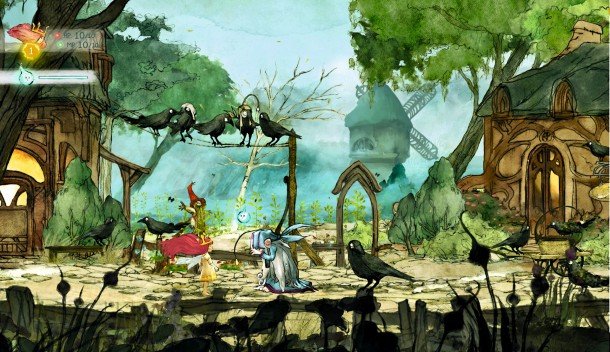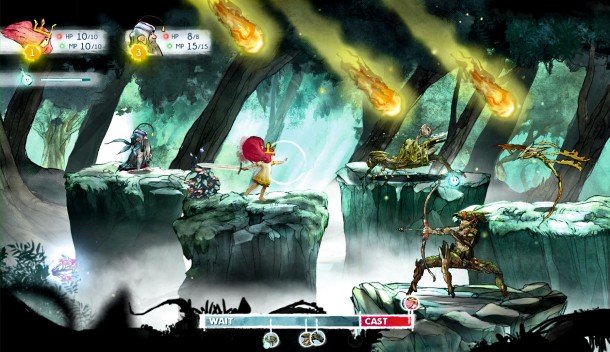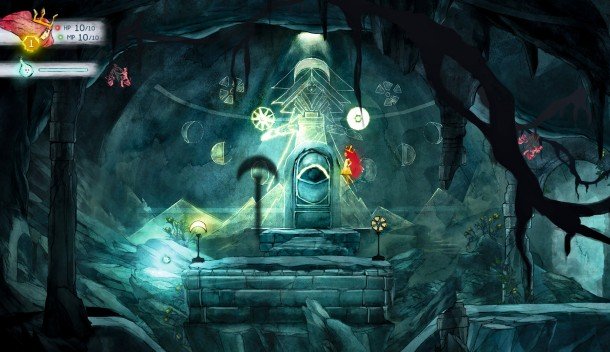Child of Light first look: tactical, turn-based combat in a beautiful fairytale world

I'm floating through a dreamy artscape, whisking little heroine Aurora across a watercolour sky in a side-scrolling Eastern European fairytale. The villagers have been transmogrified into crows, crying “caw” as I pass, probably to say “why am I a crow?”
Aurora's soul woke up here in the darkened kingdom of Lemuria, and she's somehow the natural choice to restore the light stolen by an evil queen. But first, crows. Igniculus, Aurora's floating lightball companion, guides us to a distressed old man named Finn, who points to a poisoned well as the cause of all the birdifying. The three of them speak in rhymes, and set against the loosely applied, rich colours of the village, they're clearly the heroes of a storybook.
Oddly, after Finn, Igniculus and Aurora climb into the well, Child of Light becomes a tactical game with turn-based combat. It's a strange transition – Igniculus and I are doing lazy looptyloops through a serene cavern beneath the well, collecting swirling strings of orbs to earn mana, and then I bump into an earthy insect beast and slam to a halt. My party members take combat stances opposite a trio of enemies, and Aurora's feather-like freedom of movement is gone.

Each party member and enemy has an action bar that fills, although this can be interrupted by some attacks. Once mine is full, I choose from a selection of RPG combat clichés: use a potion, cast a spell, execute a melee attack, or defend. Meanwhile, Igniculus floats around the screen – controlled by a second player, if you have one – blinding enemies with bursts of light and healing the fighters.
Before levelling up and establishing a tactic, I discover and get brutally cut down by a dragon boss. After a few lesser fights, however, I develop a nearly infallible flowchart strategy. Finn always guards, giving him total protection from one attack, or heals Aurora, while Aurora always attacks. Since the enemies focus on Finn, we're tough to take down.
The fight is still close when I return to the boss – his double attacks break through Finn's defence – but with a group healing spell and Aurora's earth magic, the beast falls right on cue, before his final attack can finish us off.

That's the way of the classic Japanese RPG (or in this case, French Canadian). Go as far as you can until you die, and by the time you get back you'll have accrued enough experience to wreck a oncechallenging enemy and adventure on to the next. As progression leads to new spells, stat enhancements, party members, and enemies, it's apparent that Child of Light's by-the-book combat will become more complex and harrowing. The juxtaposed floating sidescrolling, however, is incongruously sweet and simple, and left me with a better impression.
The biggest gaming news, reviews and hardware deals
Keep up to date with the most important stories and the best deals, as picked by the PC Gamer team.
It takes some skill to hit the snaking chains of mana orbs in the correct order, but the exploration is otherwise gentle. Aurora will surely float into trickier, more dangerous environments and puzzles, but even when its easy, Child of Light holds my attention with its style and cheer.

Tyler grew up in Silicon Valley during the '80s and '90s, playing games like Zork and Arkanoid on early PCs. He was later captivated by Myst, SimCity, Civilization, Command & Conquer, all the shooters they call "boomer shooters" now, and PS1 classic Bushido Blade (that's right: he had Bleem!). Tyler joined PC Gamer in 2011, and today he's focused on the site's news coverage. His hobbies include amateur boxing and adding to his 1,200-plus hours in Rocket League.

